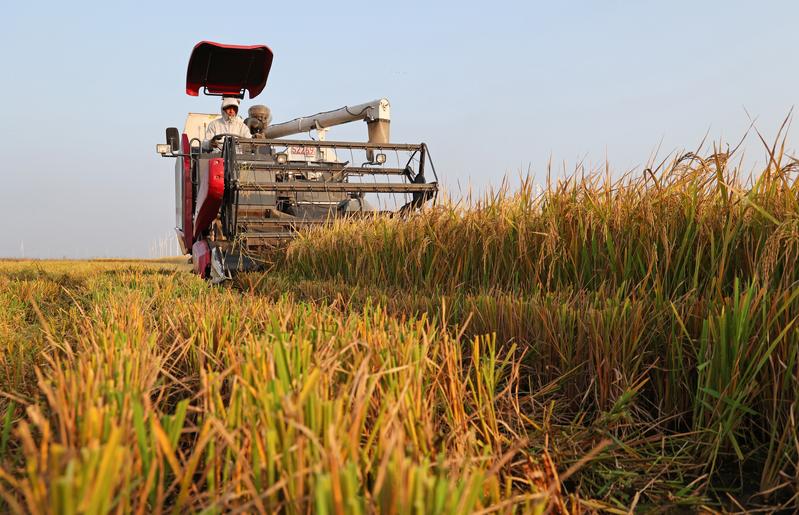Despite droughts and prolonged heat, nation's farmers guarantee food security
 A harvester reaps rice on a farm in Anqing, Anhui province, on Nov 26. (LI LONG / FOR CHINA DAILY)
A harvester reaps rice on a farm in Anqing, Anhui province, on Nov 26. (LI LONG / FOR CHINA DAILY)
China reported its highest-ever annual grain output on Monday, though its per-unit output dipped slightly due to extreme weather and an expanded growing area for import-reliant soybean.
In 2022, the country's total growing area expanded 0.6 percent to 118.3 million hectares, while overall grain output increased 0.5 percent to 686.5 million metric tons, according to the National Bureau of Statistics.
About 633 million tons of the grain consisted of rice, wheat, corn, sorghum and other cereal crops, the bureau said. That number was up 490,000 tons from a year ago despite their total growing area shrinking by 0.9 percent to 99.2 million hectares, it said.
The difference means the yield of cereal crops per hectare climbed 1 percent from a year ago to 6.3 tons. That stands in contrast with the average output per hectare, which dipped 0.1 percent to 5.8 tons.
Wang Guirong, director of the bureau's rural division, said that thanks to the concerted effort by each locality and every department, annual grain production has stayed above the country's food security benchmark — which was set by the central government at about 650 million tons — for the eighth consecutive year.
The increase came as autumn rain had delayed winter wheat, Omicron-fueled outbreaks disrupted farming and the persistent heat led to droughts in southern areas, said a statement released in tandem with the figures.
"Because of the droughts in the south, the output of rice was 7.8 tons per hectare, and that is 34.5 kilograms lower than the level last year," he said.
The "structural adaptation", which has featured decreased planting of high-yield corn and expanded growing of soybean, has also dampened the productivity per unit, he added.
Gou Tianlai, a professor at Beijing University of Agriculture, said the expanded and more lucrative vegetable-growing businesses in southern provinces also partly explain the shrinking growth of cereal crops.
The NBS data showed that 23 of the mainland's 31 provincial regions registered growth in food production.
Henan's grain output increased by 2.45 million tons from the low base of last year, when the province was devastated by heavy rains and floods.
The Xinjiang Uygur and Inner Mongolia autonomous regions, and Shandong, Shanxi and Jilin provinces each saw an increase of more than 400,000 tons.
The upturn comes as China is racing to build high-standard farmland for large-scale mechanical farming.
Authorities also showered farmers with 40 billion yuan ($5.7 billion) in subsidies to keep them from giving up growing rice, wheat and other less lucrative crops.
Gou noted that large swaths of farmland used to be deserted in rural areas as a result of an exodus of younger farmers.
The trend is set to reverse as large numbers of businesses have sprung up to provide professional "agricultural services" for farmers who do not want to or cannot till the land themselves.
"That helps integrate farmers into the modern agricultural system," he said.


